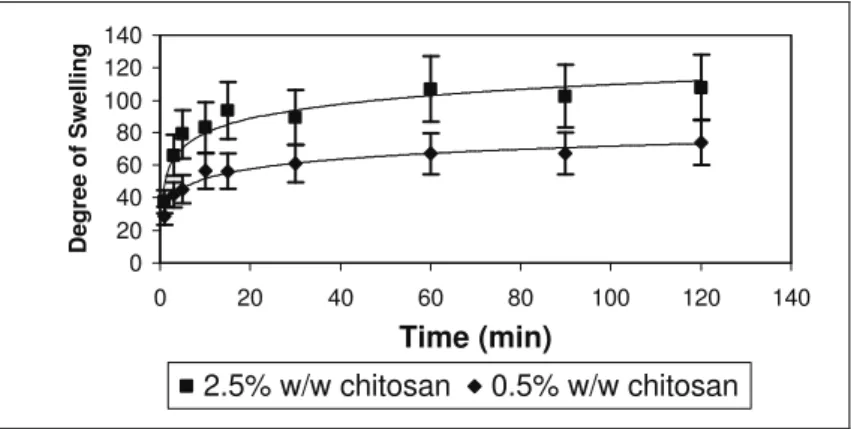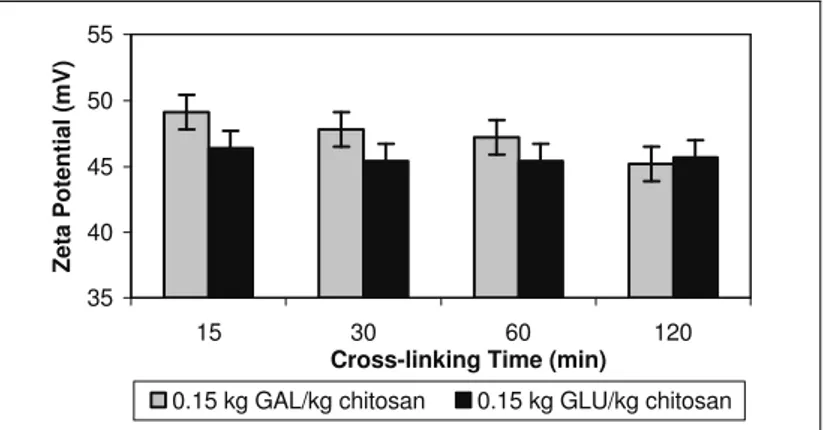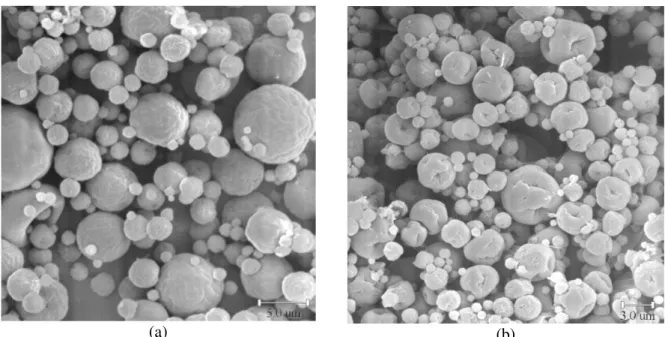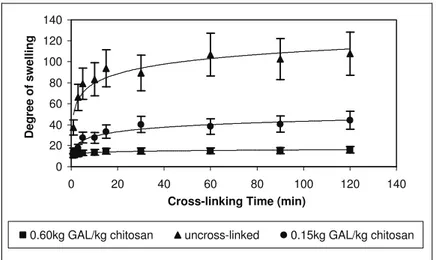ISSN 0104-6632 Printed in Brazil
www.abeq.org.br/bjche
Vol. 22, No. 03, pp. 353 - 360, July - September, 2005
Brazilian Journal
of Chemical
Engineering
SPRAY-DRIED CHITOSAN MICROSPHERES
CROSS-LINKED WITH D, L-GLYCERALDEHYDE
AS A POTENTIAL DRUG DELIVERY SYSTEM:
PREPARATION AND CHARACTERIZATION
B. F Oliveira
1,2, M. H. A. Santana¹ and M. I. Ré²
*1
School of Chemical Engineering, Laboratory of Biotechnology Process Development, P.O. Box 6066, 13083-970, Campinas - SP, Brazil
2
IPT - Institute for Technological Research of the State of São Paulo, Chemistry Division, Laboratory of Particles Technology, Cidade Universitária, 05508-901, São Paulo - SP, Brazil.
E-mail: mire@ipt.br
(Received: October 20, 2004 ; Accepted: March 31, 2005)
Abstract - Chitosan microspheres of a small particle size and with good sphericity were prepared by a spray-drying method followed by treatment with a linking agent. Owing to restrictions on the use of cross-linked chitosan microspheres in the pharmaceutical field, d,l-glyceraldehyde, a biocompatible reatant was used. The parameters studied affecting extent of cross-linking were cross-linking time and concentration of the cross-linking agent. Glutaraldehyde, the aldehyde most frequently employed as chemical cross-linking agent for proteins, was also used as a control. The cross-linked spray-dried chitosan microspheres were analyzed with respect to their morphological aspects, particle size, zeta potential and water uptake capacity. It was found that an increase either in d,l-glyceraldehyde concentration or in duration of cross-linking caused a decrease in both the swelling capacity and the zeta potential of the chitosan microspheres. Compared to glutaraldehyde, d,l-glyceraldehyde appears to be a good cross-linking agent for chitosan microspheres with the advantage that it is nontoxic.
Keywords: Glyceraldehyde; Chitosan microspheres; Cross-linking; Spray drying.
INTRODUCTION
Chitosan, a natural cationic polysaccharide, has many applications in the pharmaceutical and biomedical fields, which have been extensively reviewed in the literature (Akbuga, 1995), due to its favourable characteristics such as nontoxicity, biocompatibility, biodegradability and properties such as bioadhesion. The pharmaceutical application of chitosan microspheres as controlled drug delivery
its mucoadhesive properties and make chitosan suitable for delivery of drugs via the nasal or the gastrointestinal route (He et al., 1999).
Processing techniques for the preparation of chitosan microspheres have been extensively developed since the 1980s. Four main approaches have been proposed: ionotropic gelation with an oppositely charged, simple or complex coacervation, emulsification/solvent evaporation and, more recently, spray drying (Huang et al., 2003). The study of chitosan microsphere formation by the spray-drying method is justified by interesting results presented in the literature. Chitosan microspheres obtained by this method are characterized by high sphericity and specific surface area, parameters that are important for application in the pharmaceutical field (drug delivery systems).
Concerning the release of drugs from chitosan microspheres, various release profiles may be possible, depending on the relative magnitude of the rate of polymer swelling to the rate of drug diffusion. Frequently, the rate of drug release from hydrogels can be regulated by controlling the cross-linking density and the extent of water swelling (Kim and Lee, 1992). In many studies, chitosan has been cross-linked with aldehydes, such as glutaraldehyde and formaldehyde, to make it a more rigid polymer for use as a core material in research on controlled release. However, biological acceptance of these cross-linked products depends upon the amount of cross-linking agent in the final products and the toxicity of aldehydes has been enormously limited the utilization of the cross-linked chitosan microparticles in the pharmaceutical field. Owing to restrictions on the use of toxic cross-linkers, d,l-glyceraldehyde has been proposed as a biocompatible cross-linking agent for protein microspheres (Vandelli et al., 1995), since its use does not present toxicity problems, as it is found in the human organism as a metabolic product of fructose. In this work, the chemical cross-linking of
d,l-glyceraldehyde with spray-dried chitosan
microspheres was studied. The method consists of exposing spray-dried microspheres to the cross-linking agent in liquid phase and under mild conditions. The effects of the preparation variables (linker concentration and duration of cross-linking) was evaluated with regard to morphological aspects, particle size, zeta potential and the swelling behavior of the microspheres.
MATERIALS AND METHODS
Purified chitosan, MW 455.000 Da, degree of deacetylation 74.8%, Cyrbe® (Brazil) was used. Glutaraldehyde aqueous solution 25% w/w (GLU) and d,l-glyceraldehyde 98% (GAL) were purchased from Aldrich (Aldrich, USA). All other reagents and solvents were of analytical grade and were used as provided.
Preparation of the Chitosan Microspheres
Chitosan microspheres were prepared by a spray-drying technique. The chitosan solutions to be spray dried were prepared by dissolving chitosan in deionized water containing 0.7%w/v acetic acid. The viscosity of the chitosan solutions was measured at 25 ± 1°C using a Brookfield DVII-L (LVT-DVII) viscosimeter. The solutions were then spray dried with a 0.7 mm two-fluid pressurized atomizer at a feed rate of 6 ml/min in a Büchi-B190 spray dryer (Büchi, Switzerland). The atomizing air flow rate was 500-600 NL/h. The inlet temperature was controlled at 122-125ºC and the outlet temperature was determined by the inlet temperature and relative factors such as air and liquid flow rates, varying between 85 and 90ºC.
Cross-Linking of the Spray-Dried Chitosan Microspheres
A 2.5%w/w chitosan concentration solution was retained for the preparation of spray-dried
microspheres to be cross-linked with d,l
-glyceraldehyde (0.15 kgGAL/kgchitosan or
0.6kgGAL/kgchitosan) and glutaraldehyde (0.15
kgGLU/kgchitosan). The uncross-linked microspheres
were suspended under magnetic stirring (500 rpm) for different time intervals (15, 30, 60 and 120 min) in 60 ml of acetone-water (2:1, v/v) solutions containing D,L-glyceraldehyde or glutaraldehyde. Temperature was kept at 5ºC throughout the procedure. After the cross-linking procedure, the microspheres were filtered, quickly washed with acetone precooled to 5ºC and then vacuum-dried for at least 24 h.
Microsphere Characterization
§ Particle Size
distribution of a suspension of chitosan microspheres in 100% anydrous ethanol by laser light diffraction. Average particle size was expressed as the volume mean diameter (D4.3). Polydispersity was given by a
span index, which was calculated by (D0.9 – D0.1)/D0.5
where D0.9, D0.5 and D0.1 are the particle diameters
determined respectively at the 90th, 50th and 10th percentile of undersized particles.
§ Zeta Potential
The microparticles were dispersed in deionized water at pH 6.0 and the surface charge (zeta potential) was measured by laser doppler anemometry using a Zetamaster (Malvern, UK).
§ Morphology
Samples of microspheres were mounted on a sample holder, sputter-coated with a thin layer of Au and examined with a JEOL JSM5200 electron microscope at an intensity of 15kv, using various magnifications.
§ Swelling properties
The water uptake of the unlinked and
cross-linked chitosan microspheres was measured
gravimetrically by swelling microspheres in deionized water (pH 6.0, 37°C) and measuring their changes in weight during swelling. A given number of microspheres were first weighed inside a dialysis membrane, which was then introduced into the medium under continuous stirring at 50 rpm and allowed to swell during 120 min. The swollen samples were removed periodically (0, 1, 3, 5, 10, 15, 30, 60, 90 and 120 min) and their net weight was determined by first blotting their surfaces with a filter paper to remove medium adsorbed on the surface and then immediately weighing on an electronic balance. Each swelling experiment was repeated twice and the average value was taken as the degree of swelling, calculated as given by Equation (1):
t 0
0
(M M )
Degree of swelling
M
−
= (1)
Where M denotes the weight of the swollen t sample at time t and M , the initial weight of the 0 sample before swelling.
RESULTS AND DISCUSSION
The Effect of Chitosan Concentration on Microsphere Characteristics
First chitosan microspheres were prepared by a spray-drying method without the addition of any cross-linking agent (uncross-linked). Two chitosan concentrations (0.5% w/w and 2.5%w/w) were chosen from a previous determination of the exponential relationship between chitosan concentration and the solution viscosity (data not shown here). From preliminary tests, it was found that solutions with a chitosan concentration higher than 2.5%w/w were too viscous to be broken in to drops of controlled morphology and size.
The spray-dried microspheres obtained from the 0.5% w/w and the 2.5%w/w chitosan solutions were characterized with respect to size distribution, morphological characteristics, zeta potential and swelling properties. The characteristics of the microspheres are summarized in Table 1. Spray-dried chitosan microparticles were positively charged, with a mean particle size ranging from 3.4 to 6.7 µm. As can be seen, larger microspheres with greater size dispersion were formed from the more concentrated and more viscous chitosan solution. This was probably due to the effect of solution viscosity on the size of the droplets formed during the atomization step. In general, the mean size of droplets formed by atomization is proportional to liquid viscosity and surface tension (Ré, 1998) and indirectly affects the size of the spray-dried powder, which is an important processing variable.
SEM microphotographs of the chitosan microspheres are presented in Figure 1, showing their almost spherical form, independent of chitosan concentration in the aqueous solution.
Table 1: The effect of chitosan concentration on the characteristics of the resulting spray-dried microsphere.
Chitosan solution Spray-dried chitosan microspheres
Size (µm) Concentration
(% w/w)
Viscosity (N.s/m2)
D 4.3 D 0.1 D 0.9 Span
Zeta potential (mV)
0.5 0.008 3.42 1.06 6.65 1.99 + 53.7 ± 1.2
2.5 0.483 6.74 1.13 13.44 2.21 + 55.3 ± 0.6
(a) (b)
Figure 1: SEM microphotographs of chitosan microspheres obtained by spray drying from aqueous solutions with: a) 0.5%w/w chitosan; b) 2.5%w/w chitosan (magnification of 3500x).
0 20 40 60 80 100 120 140
0 20 40 60 80 100 120 140
Time (min)
Degree of Swelling
2.5% w/w chitosan 0.5% w/w chitosan
The Effect of Cross-Linking on the Characteristics of the Spray-Dried Chitosan Microspheres
In order to prepare microspheres with a controlled water-uptake capacity, d,l-glyceraldehyde was tested as a promising cross-linking agent for chitosan. Chitosan microspheres were also cross-linked with glutaraldehyde, the aldehyde most frequently used for cross-linking proteins (Bulgarelli et al., 1999) and also chitosan (He et al., 1999; Berthold et al., 1996), as a control.
The effects of d,l-glyceraldehyde and glutaraldehyde on the swelling behavior of the cross-linked chitosan microspheres are shown in Figure 3. It can be seen that both cross-linking agents were able to hinder the swelling capacity of the uncross-linked chitosan microspheres, also shown in the same figure as a reference. As the cross-linking time increased, the equilibrium degree of swelling decreased.
d,l-glyceraldehyde seems to be more effective than glutaraldehyde in controlling the swelling properties of the chitosan microspheres, when used under similar conditions of concentration and cross-linking time.
The extent of cross-linking might determine the
number of free amino groups which are responsible for the positively charged chitosan microsphere surface. The effect of cross-linking time on the surface charge of the chitosan microspheres was also studied and is shown in Figure 4. It was found that cross-linking with glutaraldehyde resulted in a decrease in the zeta potential of the chitosan microspheres from +55mV (not shown in the figure) to nearly +47mV in the first 15min. However, after this initial interval, the surface charge remained unchanged. This finding is in agreement with the results obtained by Berthold et al. (1996), who also observed only a slight variation in the zeta potential of chitosan microspheres after cross-linking with glutaraldehyde. In contrast, the zeta potential of the
chitosan microspheres cross-linked with
d,l-glyceraldehyde seemed to decrease with longer periods of cross-linking. These findings are probably related to the mechanisms of cross-linking, but they are not so clear at this time and interpretation of these data will require a better understanding the reactivity of both cross-linking agents and how their molecular structure affects the extent of cross-linking with chitosan.
0 20 40 60 80 100 120 140
15 30 60 120
Cross-linking Time (min)
Equilibrium degree of swelling
GAL cross-linking GLU cross-linking uncross-linked microspheres
Figure 3: The effect of cross-linking time on the water uptake capacity of the chitosan microspheres cross-linked with d,l-glyceraldehyde and glutaraldehyde.
35 40 45 50 55
15 30 60 120
Cross-linking Time (min)
Zeta Potential (mV)
0.15 kg GAL/kg chitosan 0.15 kg GLU/kg chitosan
cross-linked with d,l-glyceraldehyde and glutaraldehyde. From our results, a linear relationship was found
between the swelling capacity and the surface charges of the d,l-glyceraldehyde cross-linked microsphere as shown in Figure 5. The cross-linking density in the microspheres could be increased by duration of the chemical treatment, thereby reducing and controlling the effect of hydration and the number of free amino groups which are responsible for the positively charged chitosan microsphere surface. This effect was directly increased by increasing duration of the chemical treatment.
SEM microphotographs of the chitosan microspheres cross-linked with d,l-glyceraldehyde and glutaraldehyde are compared in Figure 6. No visible changes in the morphological aspect of the spray-dried chitosan microspheres due to the chemical cross-linking were
observed, compared to the uncross-linked microspheres already shown in Figure 1.
In order to verify if the extent of cross-linking was
proportional to the concentration of
d,l-glyceraldehyde, spray-dried chitosan microspheres were also treated after synthesis with 0.60kgGAL/kgchitosan during 120 min and characterized
with respect to their swelling properties. The evolution of the degree of swelling as a function of time of incubation in water at pH 6.0 can be seen in Figure 7. As illustrated, for the same treatment duration (120 min), the swelling capacity of the spray-dried chitosan microspheres was strongly reduced when the cross-linking agent concentration
was increased from 0.15kgGAL/kgchitosan to
0.60kgGAL/kgchitosan.
0 20 40 60 80 100 120 140
40 45 50 55 60
Zeta Potential (mV)
Equilibrium degree of
swelling
Figure 5: Relationship between the equilibrium degree of swelling and the zeta potential of spray-dried chitosan microspheres chemically treated with d,l-glyceraldehyde
(0.15kgGAL/kgchitosan) during time intervals varying from 15 to 120 min.
(a) (b)
Figure 6: SEM microphotographs of spray-dried chitosan microspheres after treatment with: (a)
0 20 40 60 80 100 120 140
0 20 40 60 80 100 120 140
Cross-linking Time (min)
Degree of swelling
0.60kg GAL/kg chitosan uncross-linked 0.15kg GAL/kg chitosan
Figure 7: The effect of d,l-glyceraldehyde concentration on the swelling behavior of the cross-linked chitosan microspheres treated for 120 min.
CONCLUSIONS
Chitosan microspheres with controlled swelling properties could be obtained by a spray- drying process followed by a chemical treatment with
d,l-glutaraldeyde.
Swelling is governed mostly by the cross-linking density of the polymer network and in this work it could be modulated over a wide range through manipulation of different manufacturing conditions such as chitosan concentration in the solution used to prepare the uncross-linked chitosan microspheres, duration of the crosslinking treatment and concentration of the cross-linking agent.
The linear relationship found between the equilibrium degree of swelling and the zeta potential of the chitosan microspheres, might represent a useful tool to control properties such as permeability to solutes and bioadhesiveness by a suitable adjustment of the extent of cross-linking of the chitosan microspheres with d,l-glutaraldeyde.
Finally, these results suggest that spray drying
followed by a chemical treatment with
d,l-glutaraldeyde may be a promising way to produce good spherical chitosan microspheres with a narrow range of particle size for controlled drug delivery. At the present time, permeability to solutes and the bioadhesive properties of these cross-linked chitosan microspheres are being studied in our laboratory. It is still too early to conclude whether spray drying will play a major role in this area of pharmaceutical processing, but interdisciplinary research ranging from particle engineering to the pharmaceutical area
is strongly encouraged to advance our knowledge in this very challenging area.
ACKNOWLEDGMENTS
The authors are thankful to CAPES. The chitosan was kindly provided by CYRBE® do Brasil Ltda.
REFERENCES
Akbuga, J. (1995), A Biopolymer: Chitosan, International Journal of Pharm. Advances, vol. 1, pp. 3-18. Berthold, A., Cremer, K. and Kreuter, J.(1996),
Influence of Crosslinking on the Acid Stability and Physicochemical Properties of Chitosan Microspheres, S.T.P. Pharma Sciences, vol. 6, no. 5, pp. 358-364.
Bulgarelli, E., Forni, F. and Bernabei, M.T. (1999), Casein/Gelatin Beads:I. Cross-linked Solution Composition Effect on Cross-linking Degree, International Journal of Pharmaceutics, vol. 190, pp. 175-182.
He, P., Davis, S.S. and Illum, L. (1999), Chitosan Microspheres Prepared by Spray-drying, International Journal of Pharmaceutics, vol. 187, no. 1, pp. 53-65.
Kim, C.J. and Lee, P.I. (1992), Synthesis and Characterization of Suspension-polymerized Poly(Vinyl Alcohol) Beads with Core-Shell Structure, Journal of Applied Polymer Science, vol. 46, no. 12, pp. 2147-2157.
Ré, M.I. (1998), Microencapsulation by Spray Drying, Drying Technology, vol. 16, no. 6, pp.
1195-1236.
Vandelli, M.A., Pifferi, G., Seghizzi, R. and Cameroni, R. (1995), Swelling Behaviour of
Gelatin Microspheres Crosslinked with d,l



